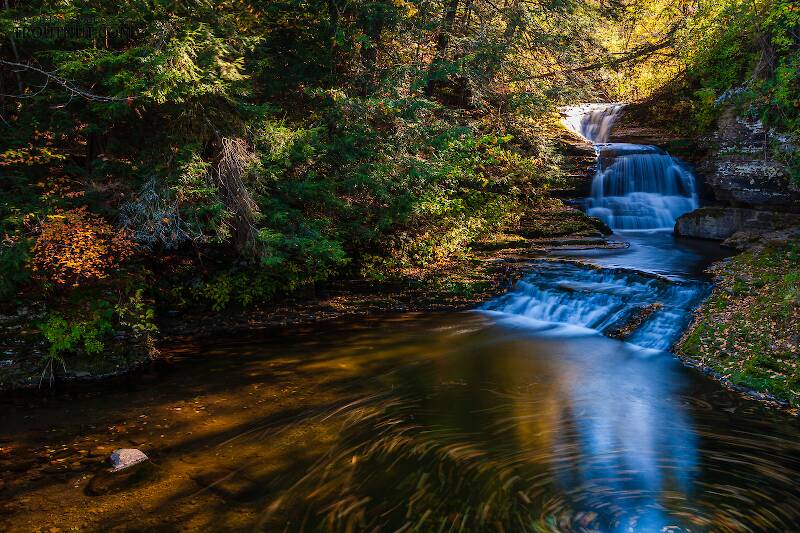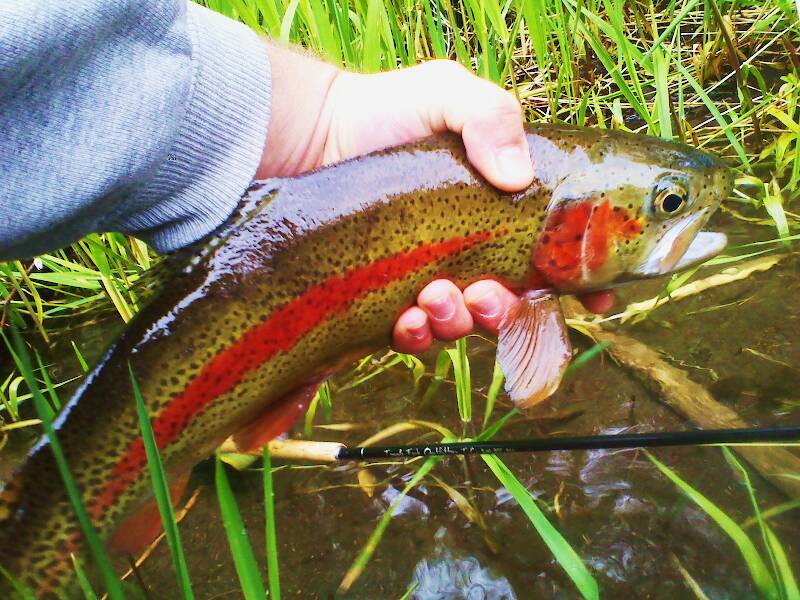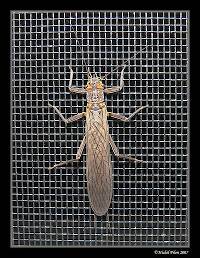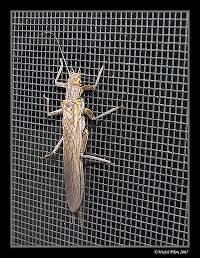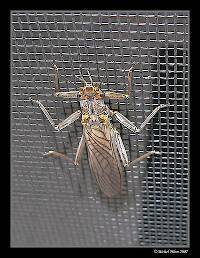
Hex Mayflies
Hexagenia limbata
The famous nocturnal Hex hatch of the Midwest (and a few other lucky locations) stirs to the surface mythically large brown trout that only touch streamers for the rest of the year.
Featured on the forum

This is an interesting one. Following the keys in Merritt R.W., Cummins, K.W., and Berg, M.B. (2019) and Jacobus et al. (2014), it keys clearly to Ephemerella. Jacobus et al provide a key to species, but some of the characteristics are tricky to interpret without illustrations. If I didn't make any mistakes, this one keys to Ephemerella mucronata, which has not previously been reported any closer to here than Montana and Alberta. The main character seems to fit well: "Abdominal terga with prominent, paired, subparallel, spiculate ridges." Several illustrations or descriptions of this holarctic species from the US and Europe seem to match, including the body length, tarsal claws and denticles, labial palp, and gill shapes. These sources include including Richard Allen's original description of this species in North America under the now-defunct name E. moffatae in Allen RK (1977) and the figures in this description of the species in Italy.

Troutnut is a project started in 2003 by salmonid ecologist Jason "Troutnut" Neuswanger to help anglers and
fly tyers unabashedly embrace the entomological side of the sport. Learn more about Troutnut or
support the project for an enhanced experience here.
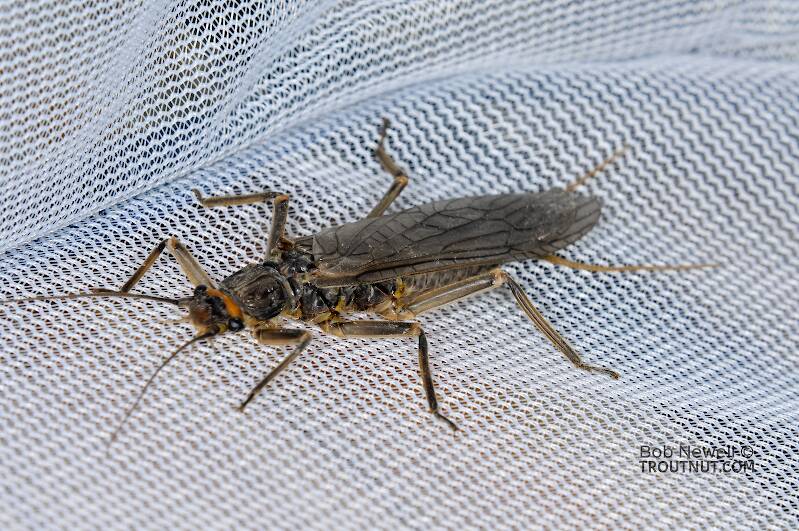
I think this is one of the most poorly understood of the golden stoneflies. It is rare to see any articles about it or fishing the hatch. It emerges late in summer usually on medium to large rivers.The adults are quite secretive but it is something to see the adults run across the water surface. These guys can really run. The males have short wings.The females are up to 1 1/4 inch long rivaling the salmonfly as the largest adult stonefly in the west.The adults are not real golden in color, especially the females which are more of an off yellow to off white abdomen. In handling the adults it is obvious that they shun direct sunlight. I find them by turning over rocks close to the water's edge.
Flymonster on Sep 7, 2011September 7th, 2011, 8:15 pm EDT
Is this the species known commonly as Short-winged Stonefly?
Dave
Dave
Fish or not to fish, there is no question.
ALWAYS FISH!
Dave
ALWAYS FISH!
Dave
GONZO on Sep 7, 2011September 7th, 2011, 8:23 pm EDT
Yep.
Sayfu
Posts: 560
Posts: 560
Sayfu on Sep 10, 2011September 10th, 2011, 5:42 am EDT
This bug is a happening out on my South Fork of the Snake. What is misunderstood is the fact that ONLY the males have short wings, and can not fly, or if they do, just short "hops". They scurry around on the small Island rocks exposed by the dropping water in the Fall, or late Summer. The females are bigger, and fly well, always flying up river egg laying very early in the morning. Some guides schedule to put in at 4:30 in the AM to time these female flights/egg laying flights. Big golden stone dries are fished around the overhanging branches. And one the rocky Island banks, and off the drop off ends of these rock islands Chernobyl ants are surface dragged to imitate the males that will skitter over the surface if when they get blown into the water...many think both male and females are mutants..not so.
Sayfu
Posts: 560
Posts: 560
Sayfu on Aug 15, 2012August 15th, 2012, 7:32 am EDT
The question I see raised out my way, is are these Mutants, or short-wings as they are called closely related to the Golden Stone, or not? A number of our guru's out here call them a late golden stone not wanting to mix words I guess. I asked Jay Buchner, a great fly tier and bug expert from Jackson, Wy. this question at our big fly tying Expo this Spring..he shrugged his shoulders) The confusion I have as well, is I don't put in early enough to see these early hour upriver migrations of females along the brushy banks egg laying. What I see when I put in at gentleman's hours are big winged critters, their wings shining in the sunlight flying overhead, and not knowing if they are a female Mutant stone, or a Fall Caddis, (dicosmoecis) I see the fly shop at our lodge at the head of the SF canyon lists SF hatches, and lists the Fall Caddis with an (*) saying (need more info) Wish I could catch one, but when I see them flying it is around lunch time. :)
Taxon on Aug 15, 2012August 15th, 2012, 10:22 am EDT
Hi Jere-
I assume your question pertains to the Shortwinged Stone (Classennia sabulosa), whose adult males are shirt-winged and adult females are full-winged. The answer is yes, they are closely related to the Golden Stones (Calineuria californica, Hesperoperla pacifica, and Doroneuria baumanni), as all four are in stonefly family Perlidae.
I assume your question pertains to the Shortwinged Stone (Classennia sabulosa), whose adult males are shirt-winged and adult females are full-winged. The answer is yes, they are closely related to the Golden Stones (Calineuria californica, Hesperoperla pacifica, and Doroneuria baumanni), as all four are in stonefly family Perlidae.
Sayfu
Posts: 560
Posts: 560
Sayfu on Aug 21, 2012August 21st, 2012, 8:09 am EDT
And the ones doing the running are the males. The water drops on our tailwater SF of the Snake Canyon...water coming out of Palisades, and rocky Islands are exposed. These "Mutant" as they are called, or Short-winged stones (males) crawl out when the water drops, and it just dropped a bunch last nite! You seldom see these males getting blown in, or short hop flights onto the water because the surface water is often broken, and they lay so flat to the water, but they do skitter across the water. The technique is to anchor up, or the oarsman has to hold back on the oars, and you fish your Chernobyl Ant type pattern dead drifted till in nears 3/4 through the drift, and then raise the rod tip, and skitter it back towards the rocky bar. Strikes can be arm jolting. 2x, and 3x tippets at the smallest. You can get out on a rocky bar, and see these dark males scurrying over rocks, and they are very difficult to catch they are so quick.
PaulRoberts on Aug 21, 2012August 21st, 2012, 8:42 am EDT
Nifty. Thanks for sharing that Jere. Claasenia is one of two large stones here (along with Hesperoperla) that come in any numbers.
ROBS
Posts: 1
Posts: 1
ROBS on Sep 6, 2012September 6th, 2012, 3:19 pm EDT
Nice to know what these guys are. I collected a few on the Metolius in Central Ore. the last couple of days and was intrigued because they were all wrong to be the golden stones that should have been there. A guy I talked to tried to convince me they were Alderflies, but I knew that was wrong.
Entoman on Sep 9, 2012September 9th, 2012, 11:37 pm EDT
Welcome to the forum, Robs!
Yes, most of the western species of the family Perlidae (Golden Stones) are a late Spring/early Summer phenomenon. The late Summer/early Fall hatching perlid species of the Claassenia genus (Fall Short-winged Stone) does belong to the same family, but confuses a lot of western anglers without an entomological bent. For that matter, so does the late Winter/early Spring hatching Skwala genus of the entirely different family Perlodidae (Springflies). What makes it a little easier (unlike the other species under discussion) is that the Classenia genus has only a single species recognized for North America and it is the only western NA species of the entire perlid family that hatches in the late Summer through the Fall.
I really enjoy aquatic entomology beyond its significance to my fishing and have spent quite a bit of time studying up on the topic over the years. Even so, I'm not embarrassed to admit these guys confused me for quite awhile. They all look fairly similar unless you know what to look for (the differences are pretty subtle)... :)
Best regards,
Yes, most of the western species of the family Perlidae (Golden Stones) are a late Spring/early Summer phenomenon. The late Summer/early Fall hatching perlid species of the Claassenia genus (Fall Short-winged Stone) does belong to the same family, but confuses a lot of western anglers without an entomological bent. For that matter, so does the late Winter/early Spring hatching Skwala genus of the entirely different family Perlodidae (Springflies). What makes it a little easier (unlike the other species under discussion) is that the Classenia genus has only a single species recognized for North America and it is the only western NA species of the entire perlid family that hatches in the late Summer through the Fall.
I really enjoy aquatic entomology beyond its significance to my fishing and have spent quite a bit of time studying up on the topic over the years. Even so, I'm not embarrassed to admit these guys confused me for quite awhile. They all look fairly similar unless you know what to look for (the differences are pretty subtle)... :)
Best regards,
"It's not that I find fishing so important, it's just that I find all other endeavors of Man equally unimportant... And not nearly as much fun!" Robert Traver, Anatomy of a Fisherman
Sayfu
Posts: 560
Posts: 560
Sayfu on Sep 10, 2012September 10th, 2012, 6:07 am EDT
What I see is a significance to flyfishing for most all of them...I can eliminate their importance to flyfishing, identify important stages to my flyfishing importance, know where they can be found in the river/lake structure, and more. Appears to me most anglers want to discard all of that information as trivial, and not worth understanding.
PaulRoberts on Sep 10, 2012September 10th, 2012, 7:26 am EDT
I found C. sabulosa emerging (both fresh husks and mature nymphs) here in August. Oddly, I also saw one fresh husk in May at about the same elevation (~6500ft) in a different but nearby canyon stream.
Quick Reply
Related Discussions
Topic
Replies
Last Reply
11
Aug 20, 2012
by Entoman
by Entoman
2
Jul 9, 2018
by Martinlf
by Martinlf
1
Sep 9, 2008
by GONZO
by GONZO
1
Oct 24, 2006
by Troutnut
by Troutnut

